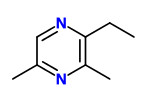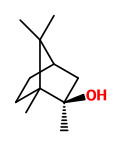Benutzer-Werkzeuge
Coffea canephora Pierre ex Froehner - syn. Coffea robusta L. Linden.; Coffea ugandae P. J. S. Cramer - Rubiaceae
robusta coffee, Congo coffeetree, Robusta-Kaffee, Tiefland-Kaffee
Shrub or small tree, 4-8m tall, native to tropical Africa, naturalized and commonly cultivated win tropics; leaves elliptic, elliptic-oblong, or ovate-oblong, crisped-undulate, apex acuminate; inflorescences with 1-3 cymes in each axil, each cyme 3-6-flowered; corolla white to pink, funnelform, tube 5-16 mm; lobes (5-7, elliptic, 8-19 mm; drupe red, subglobose, 10-12mm in diam. „This species is diploid and is cultivated as Robusta Coffee. It has been widely hybridized with several other species to produce commercial coffee plants. http://www.efloras.org/florataxon.aspx?flora_id=2&taxon_id=200022077
„The volatile components of roasted Arabica and Robusta coffees (powder and brew) were analysed by gas chromatography-olfactometry (GC/O) which revealed the odorants having the highest odor-activity values (ratio of concentration to odor threshold). This procedure resulted in 38 odorants of which 32 were identified. The powders of the two coffee varieties differed in the concentration levels of these compounds. The results indicate that the flavor difference between Arabica and Robusta coffee (powder and brew) are mainly due to the predominance of enoloxo compounds (sotolon, abhexon, furaneol, 3,4-dimethyl-2-hydroxy-2-cyclopentene-1-one) in the former and of 3,5-dimethyl-2-ethylpyrazine, 2,3-diethyl-5-methylpyrazine, 4-ethylguaiacol and 4-vinylguaiacol in the latter. Preparation of brews enhanced the flavor difference, as the concentration levels of water-soluble odorants (furaneol, sotolon, abhexon) responsible for the “sweet-caramel” flavour note increased more in the Arabica than in the Robusta coffee. On the other hand, the alkylpyrazines and guaiacols were responsible for the “spicy, harsh-earthy” aroma of the Robusta coffee. Quantification of selected odorants using a stable isotope dilution assay confirmed the differences between the Arabica and Robusta coffees (brew) found by GC/O.“
[Aroma impact compounds of arabica and robusta coffee. Qualitative and quantitative investigations. Blank, I., Sen, A.,Grosch, W., In Quatorzieme colloque scientifique international sur le cafe, San Francisco, 14-19 juillet 1991, 117-129)]
 2-ethyl-3,5-dimethylpyrazine |  4-vinylguaiacol |  2-methylisoborneol |
In various roasted Robusta coffee samples, 2-methylisoborneol was found at 120-430 ng/kg (dry matter) and assigned as earthy smelling character impact compound.
[Flavor chemistry: Thirty Years of Progress., Teranishi, R., Wick, E.L., Hornstein, I. (Eds.), Springer Science & Business Media, 1999, 122-127]
„The role of 2-methylisoborneol (MIB) in coffee aroma is controversially discussed in the literature. MIB is known as an off-flavor compound in drinking water and food, but it has also been suggested as a key flavor component of Robusta coffee, discriminating Robusta from Arabica coffee. To check this hypothesis the role of MIB in coffee brews was studied. Two reference samples containing pure Arabica and Robusta coffee brews were compared with five samples of Arabica coffee brews containing increasing amounts of MIB. The sensory panel consisting of 12 assessors perceived a distinct difference in the Arabica coffee odor and flavor in the presence of 10−25 ng/kg MIB, which is close to its threshold value in water. The sensory impression was described as musty, mold-like, and earthy. The intensity increased with increasing concentration of MIB. The panelists agreed that there was no similarity with the Robusta reference sample. The Arabica coffee brew spiked with MIB was no longer palatable due to the odor and flavor defect formed. “
[On the role of (-)-2-methylisoborneol for the aroma of robusta coffee., Blank, I., Grosch, W., Journal of agricultural and food chemistry, 50(16), 2002, 4653-4656]

Coffea canephora 2 at Aanakkulam, Author: Jeevan Jose, Kerala, India (2010)
Creative Commons Attribution-ShareAlike 4.0 International License
